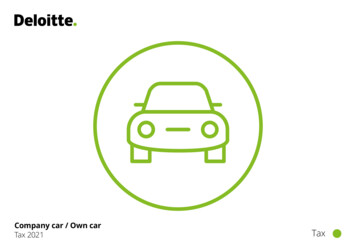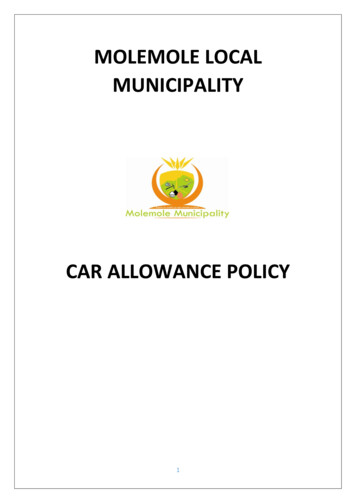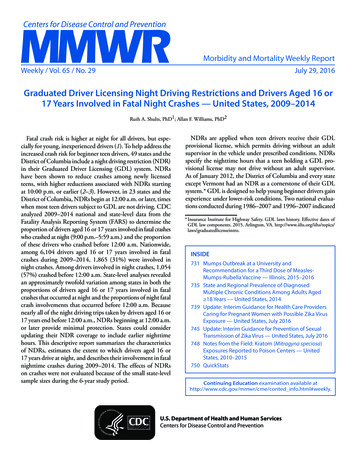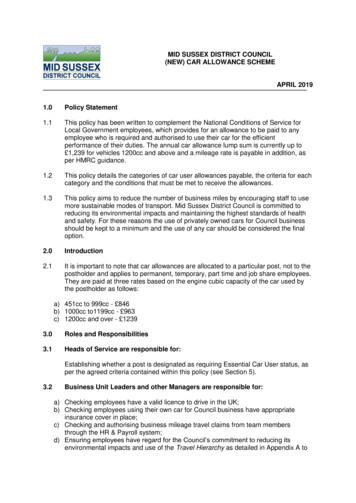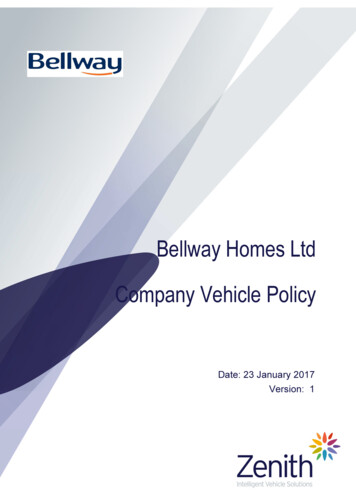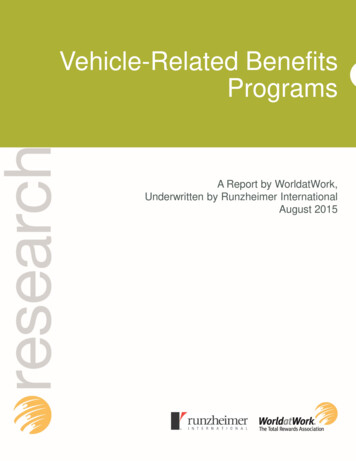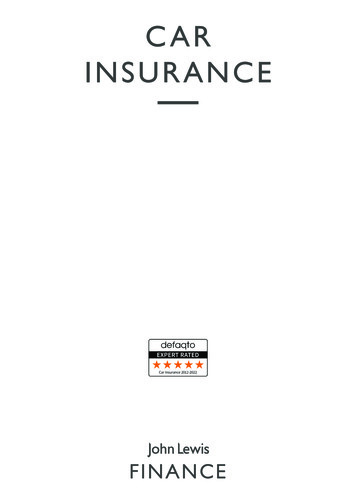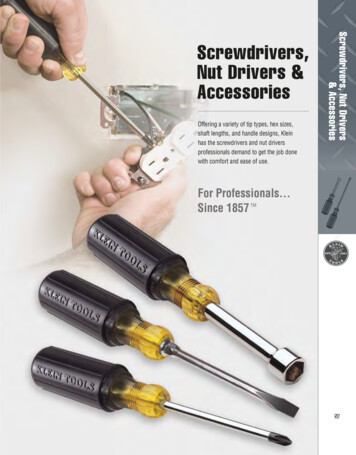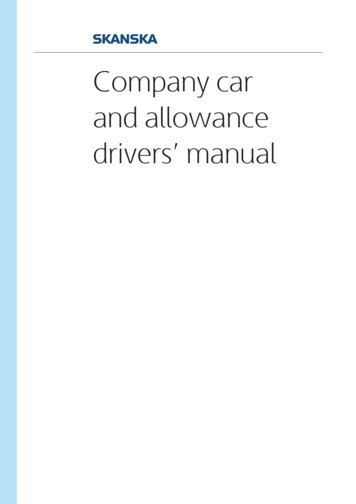
Transcription
Company carand allowancedrivers’ manual
Company car and allowance drivers’ manualContentsPolicyIntroductionAuthorised drivers of company vehiclesNew starters/newly eligible existing employeesRestrictions on use of vehiclesControl of vehicleDeductions from salaryFuelWithdrawal of company vehiclesUse of company vehicles outside the UKFixed penaltiesInsurance coverTax aspects of company vehiclesBusiness mileage claimers for drivers22233334556889DriverScheduled driving licence checksHow the driving licence verification service worksOptionsHealth and safetyDriver behaviourIncident preventionUse of mobile phones and in-car devices1010101011131416JourneysWeather conditionsDriving at nightSeasonal driving17171717VehicleCompany vehiclesMaintenance and defect reportingServicing of company carsLooking after the vehicleBreakdownsVehicle delivery and collectionThefts, incidents and damageTowing, trailers and caravansVehicle equipmentMileage recordingUseful contactsLetter from Licence BureauDVLA consent formDeclarationCar allowance declaration18181818191920212223242425272931
PolicyIntroductionSkanska (the company) is committed to providing its employees with transport for companybusiness which is both legal and suitable for purpose. The company requires all drivers todrive in accordance with the Highway Code, and ensure that their vehicles are maintained,cleaned and driven in a courteous manner in order to ensure that they portray the requiredcompany image.The company has a legal responsibility to ensure that all drivers are authorised to drive thevehicle provided, are familiar with the vehicle controls and are fully aware of their legalresponsibilities and duties.The importance of safe driving can be outlined using a few simple facts from the Health andSafety Executive: 95% of all road incidents involve some form of human error In 76% of road incidents, the human is solely to blame Most road incidents occur in built-up areas Th e most dangerous times on the road are weekdays during the rush hours between7 and 9 a.m. and between 3 and 6 p.m. Traffic incidents account for the largest single cause of death and injury for young adultsMost road incidents can be prevented with care and simple common sense actions.All employees either driving a vehicle supplied by the company or receiving a car allowancemust follow the company’s occupational road risk procedures. The company will manageoccupational road risk through individual risk assessments to ascertain the inherent hazardsof driving for work, including journeys to and from the place of work. From the results, thecompany will work with individuals or groups to increase safety whilst driving and to reducethe environmental impact of driving.All drivers will be subject to driver’s licence checks prior to being issued with a company vehicleor company car allowance. After the initial check, licence checks will be carried out annually, ormore frequently where there are more than three points on the licence. Please refer to ‘How thedriving licence verification service works’.Authoriseddrivers ofcompanyvehiclesThe company is committed to employing safe and courteous drivers, and in order to become anauthorised company driver, employees must adhere to the following criteria: Hold a full, valid driver’s licence applicable to the company vehicle allocated Submit their driving licence for validation (please refer to ‘Scheduled driving licence checks’) Be medically fit to drive in accordance with DVLA licensing laws C omplete a driver’s risk assessment prior to receiving a company vehicle or within 1 month offirst being asked if they already drive a company vehicle.All of the above are applicable to company car, car allowance and occasional drivers.2
New starters/newly eligibleexistingemployeesCompany carsCar-eligible new starters will be allocated a company car. For full terms and conditions refer tothe Skanska UK Company Vehicles Policy.N.B. I t is the employee’s responsibility to notify Her Majesty’s Revenue and Customs (HMRCthat they are in receipt of a company car/fuel card benefit. The company strongly advisesthat employees carry out this notification without delay in order to avoid a heavy taxliability in later months.Car allowanceCar-eligible new starters may be able to opt out of the company car scheme and take a cashallowance in lieu of a vehicle. Refer to the terms and conditions stated in the Skanska UK CarAllowance Policy for limitations and guidelines.Restrictions onuse of vehiclesDrivers of company cars are allowed to use the vehicle for social, domestic and pleasurepurposes as well as company business, subject to the following exceptions: Competitions Rallies Trials Pacemaking Speed testing Learner driver tuition Carriage of passengers for hire and rewardWhere goods are carried in a company car they must be secured and the vehicle must notbe overloaded.Improper use of a vehicle will result in the employee being subject to company disciplinaryprocedures.Controlof vehicleAn employee allocated a company car is the nominated driver until the vehicle is surrendered,and is responsible for the vehicle and for any driving offences and fines incurred.The nominated driver must maintain a record of any authorised persons driving their vehicle.If any motoring offence occurs while the vehicle is being driven by an unidentified third party,then the nominated driver will, as far as the company is concerned, be liable for that offence.Deductionsfrom salaryAs an employee allocated a company car for business, social and domestic use, the driver will besubject to P11D car tax rules.In the case that a charge is made to the cost centre by the contract hire company on the returnof the vehicle as a consequence of neglect in the general care and maintenance of the car, the3
employee may be required to make a contribution of up to 500. Fair wear-and-tear will beallowed for as part of the general depreciation of the vehicle.The company reserves the right to deduct monies owed due to vehicle neglect from a departingemployee’s final salary, or retain an amount subject to a vehicle being returned late. Wherethe employee has chosen to have selected manufacturer optional extras fitted at the start of acompany car contract, appropriate monthly deductions will be made from their salary overthe contract period. In the event that the driver leaves the company (except as a result ofredundancy, ill-health, early retirement or death) the balance due for the remainder of thecontract will be deducted from the final salary to the fullest possible extent. The remainingbalance must be repaid to the company prior to leaving.FuelThe company has an agreement with Shell UK for the supply of fuel cards for company cardrivers. These cards are obtainable for company cars through Fleet via e-mail –carfleet.admin@skanska.co.ukThe card is mainly for use at Shell service stations, but in exceptional circumstances will beaccepted at Esso, Total and Texaco. It must only be used to obtain fuel and lubricants for acompany car or hire car provided whilst a company vehicle is off the road.The card will show the driver’s name and employee number and must be signed by the holderon the reverse. The card may not be used by any other person.The driver must present the card to the cashier on obtaining the fuel or lubricants. Thecard holder must sign the sales voucher and retain one copy as proof of transaction in caseof discrepancies. In addition to signing the voucher the driver must check that the vehicleregistration, mileage and charge made for the fuel are correct.The card holder must ensure that the fuel card is kept in a safe place at all times, and the cardshould never be kept or left inside the vehicle.If a card is lost or stolen, contact Fleet as soon as possible, so they can place the old card on stopand apply for a replacement.During business hours, e-mail Fleet at carfleet.admin@skanska.co.uk ortelephone 44 (0)1923 423942. Outside business hours, call EuroShell on 0800 731 3131.If the old card is found after it has been stopped, do not attempt re-use as it will not work andwill be flagged by Shell as an attempt at fraudulent use.The fuel card remains the property of Shell UK Limited and must be returned to hrDirectimmediately if any of the following circumstances arise:4
The employee’s employment with the company is terminated The employee retires from company service The company vehicle is withdrawn The employee is legally disqualified from driving The employee is transferred overseas and surrenders the company vehicleIf the fuel card is damaged or has previously been reported lost and is retrieved, it should bereturned to Fleet.All fuel cards will be issued with an expiry date, and new cards will be issued automaticallybefore that date. Expired cards should be destroyed and disposed of.Improper use of a company fuel card will result in the employee being subject to companydisciplinary procedures.The vehicle allocated to an employee may be withdrawn or substituted under circumstancesWithdrawal ofcompany vehicles which the company considers justifiable, including but not limited to the following: Reduction in business mileage, and/or change of role Where there is a change in company car policy Where the driver is in breach of the rules, such as misuse or neglect of the vehicle W here an employee allocated a vehicle on a business-need basis is unable to drive the vehiclethrough disqualification, incapacity or other long-term absence W here an employee develops a medical ailment that causes the DVLA to revoke their licenceon medical groundsUse of companyvehicles outsidethe UKIf a company vehicle is to be taken out of the United Kingdom for business or holiday purposes,the following procedures must be followed: Th e vehicle leasing company should be contacted to obtain foreign travel pack (there will bean administration fee charged direct to the driver) Th e driver should make themselves aware of the road legislation for the country they aretravelling to. Breakdown cover for company cars will be obtained through the vehicle lease company An insurance certificate should be obtained from FleetIt should be noted that cover for caravans and trailers is limited to third party liability onlywhilst being towed by the company vehicle. Drivers should make their own arrangementsfor additional cover.5
Fixed penaltiesThese guidelines detail the procedures to be followed should an employee allocated a companycar incur a fine as a result of any of the following driving offences: Parking tickets Driving in bus lanes Congestion charges SpeedingAn employee who receives a ticket/fine for a driving-related offence must act upon itimmediately. Failure to do so could result in disciplinary action.Where the employee accepts responsibility for a driving offence, or there is clear evidence thatthe employee is liable, the company will be entitled to deduct from the employee’s salary/wagesthe cost of any fines not paid by the employee, plus the cost of any administration fees chargedby a third party. hrDirect will notify the employee in writing in advance of any deductionbeing made.The employee will be able to contest any fine received.The company’s fleet of cars is provided by leasing companies, who are the registered owners ofthe vehicles. Some penalty charges incurred, e.g. driving in bus lanes or unpaid parking tickets,are issued directly to the leasing company who must automatically pay the fine. The companyis then re-charged the cost of the fine, along with an administration fee. Once a fine has beenpaid, it cannot be contested with the issuing authority. Where this is the case, and the employeewishes to contest the fine, the company will review the circumstances surrounding the fine anda decision will be made on whether to reclaim the costs incurred from the employee.Drivers who regularly incur charges for traffic offences will be subject to companydisciplinary procedures.Parking ticketsEmployees must ensure that all parking ticket fines are paid promptly, or are properly contestedto prevent any escalation in charges. Employees can do this by: Immediately paying the fine directly to the charging authority, or Contesting the fine with the Issuing AuthorityIf the parking fine is not paid or acted upon, the following procedure will apply: Fleet receives a fine that may have already escalated in cost The fine will be sent directly to the driver for immediate action hrDirect will be notified. Failure to action will be subject to disciplinary procedures6
Driving in bus lanes and stopping in box junctionsDriving in bus lanes within restricted hours and stopping in box junctions are prohibited andemployees should ensure they comply with UK regulations. Photographic evidence against adriver can be provided and therefore, in most cases, these offences cannot be contested.The following procedure will apply should Fleet receive any penalty charges for thesedriving offences: Fleet receives an invoice from the leasing company for the offence F leet will arrange immediate payment of the invoice and the employee’s cost centre willbe charged A copy of the invoice/fine will be sent to hrDirect h rDirect will confirm in writing that payment to cover the cost of the fine and theadministration charge will be deducted from the employee’s salary/wagesCongestion chargesEmployees must comply with the company’s congestion charging procedure relevant to theiroperating unit, obtainable from their HR business partner. Failure to do so will result in thecompany receiving a penalty charge for the car.The following procedure will apply: Fleet receives an invoice from the leasing company for the offence F leet will arrange immediate payment of the invoice and the employee’s cost centre will becharged Fleet will send a copy of the invoice/fine to hrDirect, confirming the driver’s name h rDirect will confirm in writing that payment to cover the cost of the fine and administrationcharge will be deducted from the employee’s next salary/wages paymentSpeedingTravelling in excess of the posted legal speed limit is strictly prohibited and drivers of companyvehicles should ensure they comply with UK road traffic regulations. Photographic evidenceagainst a driver may be presented if the offence is recorded by a camera.The following procedure will apply should Fleet receive a speeding notification: F leet receives notification of the offence and identifies the driver according to the numberplate stated and records of authorised user F leet completes and returns the documentation to the police notifying them of the allegedoffending driver’s name. The police will then make contact with the driver and the relevantprocess will be applied, e.g. the driver may receive a fine and points endorsed on their drivinglicence or may be required to attend a court hearing The employee must inform hrDirect of any convictions endorsed on their driving licence7
Insurance coverInsurance policyOur current insurance company is Zurich Insurance. Please contact Fleet should you need acopy of the company car insurance certificate.Vehicles coveredVehicles covered under the company car policy include company cars and minibusesCar allowanceAny individual who receives a car allowance must ensure that their car insurance coversbusiness use. The wording that is most common on insurance certificates that provide cover forbusiness use is ‘for use in connection with his/her businesses’.All car allowance drivers are required to produce an appropriate insurance certificate every 12months (or upon change of vehicle) together with other documentation required as per SkanskaUK Car Allowance Policy.All other employees (occasional drivers)If an employee needs to make a one-off journey for business purposes they may only use theirprivate vehicle if their insurance covers them for business use. Please note that Business mileagerates (for employees without company car/car allowance) cannot be claimed unless the car isspecifically insured for business use (please refer to ‘Business mileage claims for drivers’). If theinsurance does not cover business use, the driver will need to contact their line manager to use acolleague’s company car, or to authorise an unallocated company vehicle or a hire car.If the vehicle is a personal car and only used to travel to and from work this will be stated on theinsurance certificate. The wording most commonly used on private insurance documents is ‘forsocial, domestic and pleasure use, including travelling to and from the policy holder’s place ofwork’.Demonstrator vehiclesThe company will occasionally have demonstrator cars. These vehicles are subject to the samepolicies and procedures which apply to company cars.Tax aspectsof companyvehiclesIf the company provides a company car and fuel to an employee for private use, HMRC regardsthese as taxable benefits in kind to the employee. They are called the ‘vehicle benefit charge’ andthe ‘fuel benefit charge’ respectively.The vehicle benefit charge is calculated on a percentage of the vehicle’s P11D list price,graduated according to the level of the vehicle’s CO2 emissions and fuel type. The fuel benefitcharge is determined by applying the same percentage figure used to calculate the vehicle benefitcharge to a flat-rate amount as per HMRC guidelines.8
Individuals should consider whether or not it will be cost-effective to opt out of the fuel cardbenefit. The HMRC website has worked examples which will assist drivers in making the rightchoices for their own personal circumstances. The company reserves the right to supply a fuelcard to an employeeBusiness mileageclaims for driversThis applies to all Skanska UK Plc employees.The company recognises that in certain situations employees may be required to use their owncars on company business. Where this happens the company will reimburse the employee forapproved business mileage.Approved business mileage will be reimbursed to occasional drivers, employees in receipt of acar allowance, or those in receipt of a company car but not a fuel card.Conditions Th e employee claiming a mileage rate must be the registered owner (or a named driver) of thevehicle or a nominated driver of a company car Th e vehicle must be insured for business use Th e rates may only be paid for authorised business journeys, i.e. the journey from home tonormal place of work is usually excluded C laims for business journeys should be made on the staff expenses claim form with theaccompanying mileage log A t the request of the company, an employee claiming a mileage rate may be required toproduce evidence of ownership of the vehicle for which a mileage rate is being claimed Where circumstances arise which require interpretation of the above, or are not covered by theabove, the company reserves the right to interpret or establish the appropriate rules. It is alsothe intention of the company to regularly review this policyRatesThe mileage rates are in line with HMRC guidelines and may change from time to time. Pleaserefer to the company intranet pages for the appropriate current mileage rates as they may differ,depending on whether or not the employee is in receipt of a car allowance, company car or isclassed as an occasional driver.9
DriverPolicyAll drivers will be subject to driver’s licence checks prior to being issued with a company vehicleor company car allowance.Scheduled driving The company has a legal obligation to check driving licences on a regular basis to ensure thatemployees driving on company business hold a current, valid licence. Industry best practicelicence checksrecommends that they are checked every 12 months as a minimum standard. It is a condition ofthe provision of a company vehicle or allowance that a licence check is completed.As part of the company’s improved Management of Occupational Road Risk policy (MORR),the company has entered into an agreement with the Licence Bureau for a driving licenceverification service.How the drivinglicenceverificationservice worksThe driving licence verification system is the most efficient way of checking licences, and isSkanska’s preferred option of carrying out the checks. A consent form allows the company tocheck the employee’s licence for a maximum of three years. After three years a new mandate isrequired. The service complies with the requirements of the DVLA and the Data Protection Act.OptionsSkanska’s preferred option – Enrolment into the Licence Bureau Verification System. Driverswill be enrolled into the driving licence verification system both initially and during the courseof their employment.In the event of a driver leaving the company, or electing to change their licence verificationoption, the company is responsible for removing the employee from this verification process.ReportingThe reports generated by the verification service will confirm the existence or otherwise of acurrent valid drivers’ licence and will contain the following data: Driver’s name and partial licence number Categories of licence held Current endorsements Renewal dates for any HGV/PCV licence holders Photocard expiry Licence expiry10
The frequency for rechecking licences will be based upon the number of points currentlyendorsed on a licence. The following table shows the minimum frequency of licence checks:Number of points on licence0-3 points4-7 points8 pointsFrequency of checks12 months6 months3 monthsAlternative OptionsDVLA check using their Hotline with driver permission (Stand by me)Where a driver wishes to have their licence check completed by this alternative option, thedriver will be required to attend the Fleet department at a pre-booked date and time.The driver will be required to bring with them their current driving licence and photo cardwhere applicable. The Fleet department will then call the DVLA using their Hotline facility andask the driver to speak to the DVLA to provide permission for them to verify the licence detailsjust provided to Skanska.Presentation of current driving licence and counterpart where applicable.Where a driver wishes to use this option, they will be required to present the Fleet departmentwith their current licence and counterpart where applicable for copying, which then needs to beendorsed by the driver to confirm that this is their current licence and is a true copy.Both of these alternative processes are clearly less efficient than the automated option for bothdrivers and the company, and would need to be followed every time the licence is due forchecking. Notwithstanding this, the final choice of which driver licence verification option youchoose is entirely your decision.Health and safety Employee responsibilitiesThe company requires all employees to comply with the company’s health and safety policiesand with the following in regard to MORR:All drivers must: Hold a full and valid driving licence Be qualified and competent to drive the vehicles that feature as part of their job B e aware of the guidance contained within these policies, and what to do in relation toincidents and emergencies Observe speed limits at all times, and all other road traffic laws Always drive in a courteous manner, with respect for other road users11
A dhere to the company’s mobile phone and in-car devices policy (please refer to ‘Use ofmobile phones and in-car devices’) Follow the stated incident reporting procedures Report ALL vehicle damage as soon as practicable to Fleet G ive consideration to whether the journey is essential, or if there is an alternative businessmethod which can be employed more effectively (e.g. conference calling). If more than oneemployee is travelling, consider shared driving U se all safety equipment provided, should the need arise (e.g. a warning triangle whilst brokendown) I nform hrDirect of any endorsements on their driving licence and inform the companyimmediately if their licence is revoked E nsure that the vehicle is only used in accordance with the limitations of use stated in thisdocument (please refer to ‘Restrictions on use of vehicles’) Comply with the non-smoking policy in any company vehicles I nform the DVLA and the company of any medical ailment or infirmity which may impairtheir ability to drive or in the event that an existing condition deteriorates. Failure to notifythe DVLA is a criminal offence and constitutes gross misconduct under company disciplinaryprocedures W ear corrective eyewear if prescribed (e.g. glasses, contact lenses) and undergo an eye test atleast every three years.Any employee who suffers from a medical ailment or infirmity which may affect the type ofvehicle that they drive should be referred to Fleet for approval before being authorised as acompany driver.In the event that an employee has their licence revoked for whatever reason and loses the rightto drive, and is therefore unable to carry out their contractual obligations, their employmentwith the company will be reviewed. In some circumstances the company will have no otherchoice but to terminate the contract of employment.It is a criminal offence to drive a motor vehicle if a driver cannot read a standard number platein good daylight from 20.5 metres (67 feet) using glasses if necessary. If the driver requiresglasses or contact lenses to do this they must be worn every time a vehicle is driven.If for any reason hearing has deteriorated, the driver must contact a medical practitioner to havetheir hearing tested and inform Fleet immediately so that reasonable adjustments to the vehiclecan be considered and put in place.It is the responsibility of the employee to comply with all legal requirements relating to the useof the vehicle whilst being used for business purposes, and the company shall not be liable forany fines relating to any traffic or other offence.12
Drugs and alcohol policyAs per the terms and conditions of employment, all employees must adhere to the companyDrugs and Alcohol policy.Smoking policyAs per the terms and conditions of employment, all employees must adhere to the SkanskaSmoking Policy, which states that smoking is not permitted in any company-provided vehicle.Driver behaviourRisk assessmentsThe company has a duty of care to look after the welfare of all its employees whilst driving onbehalf of the company.Risk assessments are required for all employees who drive on company-related business, inorder to help identify the hazards associated with each employee whilst driving at work. Thecompany has entered into an agreement with an external organization which has developed acomprehensive risk assessment system.All drivers will be required to complete an online risk assessment every three years. Thecompany will use the results to work with groups of drivers to increase safety and reduce theenvironmental impact of driving.Evaluating the risksIn order to ascertain which individuals are at greatest risk, the company needs to considerboth existing and potential future risk factors. There are a number of elements that need to beconsidered as part of the risk analysis: Driving experience Licence details Incident record Age Mileage Medical history Behavioural types Attitude to drivingAll approved drivers will complete a two-part online risk assessment at least every three years,analysing both situational and behavioural risk. Once completed, the driver is given a risk ratingof high, medium or low for each section. A copy of the results will be available for the driver atthe end of the assessment.If a driver’s job role or personal circumstances change (including pregnancy), this may result ina new risk assessment being undertaken.13
IncidentpreventionPreventing inappropriate use of speed E mployees are required not to exceed the speed limit and to drive safely at a speed appropriateto the road conditions. Repeated speeding offences will be regarded as a disciplinary matter J ourneys should be planned with safety in mind, allowing sufficient time to enable compliancewith speed limits, the weather and taking rest breaks I ncidents will be subject to investigation. Repeated incidents for which the driver isresponsible may result in disciplinary actionPreventing fatigue while drivingFatigue is a major cause of driving incidents due to loss of concentration and reduction inreaction speeds.The HSE recommends that as a general rule when planning a journey, drivers should allow anextra 15 minutes for every hour the journey is estimated to take. This is in addition to allowing aminimum of 20 minutes break in every two hours of driving.The following guidance shall be adhered to by all drivers: F atigue is a major cause of incidents and drivers are reminded about the dangers of fallingasleep at the wheel, the need for safe journey planning, the early signs of fatigue and times ofday when the risk is greatest – i.e. early mornings N ot driving regularly more than 350 miles in a day D rivers should be careful of the consequences of driving long distances before and after work– consideration should be given to the possibility of staying overnight if appropriate I f feeling tired, drivers should stop in a safe place and take a break before continuing theirjourney. By following these guidelines it is possible to reduce the likelihood of being involvedin a road collision or road rage incident, or suffering stress and fatigue.Driver competence Company car drivers must be competent to drive the vehicles that feature as part of their job A ll drivers must be aware of the guidance contained within these policies, and what to do inrelation to incidents and emergencies D rivers should ensure that vehicles are checked and serviced at the correct intervals asscheduled according to the manufacturer’s handbookPersonal safetyPersonal welfare should be maintained not only whilst actually driving, but also when n
Car allowance Car-eligible new starters may be able to opt out of the company car scheme and take a cash allowance in lieu of a vehicle. Refer to the terms and conditions stated in the Skanska UK Car Allowance Policy for limitations and guidelines. Drivers of company cars are allowed to use the vehicle for social, domestic and pleasure
